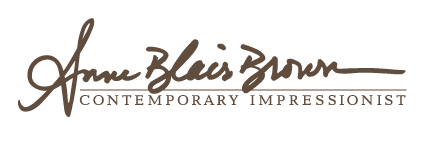The purpose of the painter is simply to reproduce in other minds the impression which a scene has made upon him. A work of art does not appeal to the intellect. It does not appeal to the moral sense. Its aim is not to instruct, not to edify, but to awaken an emotion. –George Inness
I’ve been thinking a lot about the “notion of emotion” in artwork. Inness’s words are very impactful, although from my point of view I might have stated it a little differently, i.e., “A work of art does not necessarily have to…”, just to include the folks who DO want to edify, instruct, and appeal to a moral sense with their art, which is perfectly ok.
I, however, prefer the kind of art that makes my tummy feel tingle-y (emotion) and invites me to linger over delicious color and mark-making, regardless of subject. If you are the same kind of artist, I guess the question is: how do we execute this magical, expressive art and awaken our viewer’s emotion?
I guess the easy answer is to share with your viewer the impression the scene has made upon you, according to Inness. That is good and well, but there is still a “how?” factor here. On my own journey, I have discovered some ways to achieve emotion through mixing and applying color and also in the physicality of laying down strokes. There are some deeper and more philosophical aspects also, but it is in practicing the “how-to” part that has helped me sidestep labored, over-rendered paintings and move toward spontaneous, emotive painting.
Swing. A. Bigger. Brush. At least in the beginning. If you start with a tiny eyelash brush and labor over all the detail, you will certainly get a nice academically correct result, but maybe not so much emotion. Bigger brushes promote spontaneity and energy, which translates to emotion.
Hold your brush like you are a musical conductor holding a baton, cuz you ARE the conductor of your painting. Use a light touch at the base of the brush, then throughout the painting move the brush in different directions using your wrist, elbows, and basically your whole body. Step back and forth occasionally. All of this will create an energy that is palpable in the painting.
Sculpt with your paint. Lay in shapes and use negative space paint to carve out positive shapes. I have long believed if you have the right shapes (puzzle pieces), you have the correct drawing and perspective.
Lay it and leave it. If you keep “licking” over strokes, you will kill the spontaneity those bigger brushes are so valiantly trying to help you with (and you will probably muddy your color).
Pre-mix color pools on your palette. This achieves several things: you can see pretty color emerging before you start painting (confidence), you have lots of paint ready to scoop and go (emotion), and you can work within these color mixtures so you don’t have to reinvent the wheel over and over from your primary colors (this last one is a GREAT way to get instant color harmony).
Make color your own. You don’t have to copy everything you see. As long as the value is right, the color will be right. A few ways I own my color is by overstating or understating, using tonal underpainting to create a unified color base, and layering warm and cool to create vibration (emotion). And that’s just the tip of the iceberg.
Stop before you think you are finished. Set a timer for 30 minutes. Then stop. Check your values. Then paint in one, two, or three more 30-minutes sessions, then stop and sit with it. Does it hold together? Could you take something out rather than adding anything else in? Remember, less is more. As with music, the power is often in the pauses.
I’ll be talking about and demonstrating all this and more in my upcoming workshops, Brushwork & Color: Make Your Mark. I’m so excited about this workshop theme I decided to hold two. The first is online, Wednesdays, June 5, 12, 19, 26, 2024, and then the second is in-person at our beautiful Bluebird Hill Retreat September 18-21, 2024. In these workshops, you’ll learn to use your palette and brushes to paint your impressions with emotion. If you want to get loose and have fun doing it, I hope you’ll join me!
For more information, go to https://anneblairbrown.com/workshops-and-mentoring

